When traveling, Jackie and I invariably eat something that’s completely new to us. Sometimes it is so dependent on a local ingredient that it can’t even be parodied, let alone reproduced, back in New York. But there are generally a few dishes that we think we’ll take a stab at once we get home.
The trip from which we’ve just returned was particularly rich in that regard. For part of the time we were in Modena and Parma in the Emilia Romagna area of Italy, where lots of the cooking is centered on dairy, eggs and cured meats: lasagne; fresh pasta with ragù Bolognese; platters of variations on prosciutto, coppa, culatello and salami; shards of parmesan cheese – these are emblematic of the region and are pretty familiar to even semi-engaged diners, and certainly to any cook with a reasonably serious interest in Italian food.
Here, though, are a few dishes and cooking ideas that were new to us, or that we’d heard of but had never tasted. I’m determined to devise recipes for them and add them to the repertory, but that determination may well crumble once I get back into post-vacation cooking mode and find dinner defined more by farmers’ market produce than by travel memories. So I shall pass along my to-cook list, with accompanying snapshots, and advise you not to wait for me to give more details in a future Cooking Off the Cuff: Look these dishes up on your own and get cooking.
Having said that, I absolutely, one-hundred-percent, will soon be making calzagatti. As served at the lovely Modena restaurant Trattoria Pomposa (whose name does not mean “pompous”: it is located on Piazza Pomposa, deriving ultimately from a place), these are made of polenta combined with well-flavored stewed beans, chilled, cut into fingers, dusted with rice flour and fried to enduring crispness. (The bean-polenta mixture can also be spooned into a bowl without frying.) The flavor is heightened by adding the cooked polenta to the bean pot and simmering it for a while longer with the beans and their stewing liquid. Ours were served on a pillow of cow’s-milk ricotta, but there are many possible accompaniments. I’m thinking along the lines of a drinks snack, perhaps with a parmesan cream to dip them into.
Yes, parmesan cream. At Franceschetta58, the informal trattoria of Massimo Bottura (the chef-owner of Osteria Francescana, Modena’s three-Michelin-star restaurant), we had a dish of intense pumpkin spiked with, I think, crisped pancetta and topped with an aerated sauce made from aged parmesan. The home version would simply entail melting lots of parmesan cheese into a mixture of milk and cream, then – if possible – spritzing it out through a cream-whipping siphon. Lacking a siphon, one could make it solely with milk then fold hand-whipped cream into it to give it an airier consistency.
(Aerated parmesan cream must be a Thing, because we ate it also in Newcastle-upon-Tyne, England, at the chef Nick Grieves’s excellent restaurant The Patricia; there, it topped onion jam and Brussels sprouts and was in turn dusted with an aromatic grating of fresh truffles. Don’t let the truffles mislead you into thinking this is a fancy restaurant: it’s an easygoing place, the cooking sophisticated and entirely delightful.)
Also from Franceschetta58 (whose menu is not limited to local dishes or ingredients), here’s a tip for dried peppers: deep fry them, and they’ll develop a pleasing crunch while retaining their flavor. There, they did it with mild peppers from the southern Italian region of Basilicata, known in their dried form as peperoni cruschi. They also served an untypical dish of passatelli – a pasta made of breadcrumbs and eggs that is usually served in broth but that here were combined with octopus, potatoes, capers and lemon. Because of their fragility, I think they’re better served in the traditional way, and when I make them (using a potato ricer to extrude the worm-shaped noodles) that’s how we’ll eat them.
I don’t normally get into charcuterie (except for the occasional batch of cotechino), but I think I’ll try to make ciccioli, which we had as part of our antipasto at Trattoria Pomposa. It’s in my comfort zone because I make duck confit every year or two, and ciccioli are pork slowly cooked in lard, including cracklings from the rendered fat and gelatinous parts such as ears, pressed into the form of a cake; once it has chilled under a weight, all that gelatin holds it together for slicing. Unbelievably good: soft, unctuous and totally porky.
In Parma, we had operas to see in the evening, so, uncharacteristically, we ate lunch rather than supper. On the day of our arrival we made for Ristorante Cocchi, about a half hour’s walk from our hotel (the Mercure Parma Stendhal - a perfect location for opera-going). It serves classic Parma dishes in that sort of simple, comfortable environment that restaurants in Italy get just right. Two things there are on my list: first, Punta di vitello ripiena (oven-braised breast of veal with a bread stuffing). My mother used to stuff breast of veal with nicely seasoned bread, but this is in another world: The custard-smooth stuffing is made with bread, maybe a butter-cooked onion, eggs and lots of grated parmesan cheese. Such simplicity, such intensity of flavor; light and rich at the same time. When winter is upon us, I’ll give this a try.
On our way into the restaurant we saw a tart pan containing something golden brown. At dessert time, the waiter did not mention it, so we quizzed him. It was sbrisolona, which is rather like the topping of a fruit crumble but intended to be eaten on its own. We asked for some, and it came, full of toasty almonds and crunch, with a dish of zabaglione on the side. They sell it in pastry shops too, but even the best store-bought versions don’t have the butteriness and freshness of Cocchi’s. It’ll be easy to make, but not easy to make quite as well.
Finally, erbazzone, a thin pie filled with ricotta and one or more green vegetables, typically spinach and/or Swiss chard. We ate it in Modena at the bar/café Caffetteria Giusti, sitting outside gazing at the imposing Palazzo Ducale (now an officer-training school for the Carabinieri) and watching people and their dogs stroll by. In fact, we ate it twice: once cut into little squares as part of the cocktail-hour freebie that Italian bars offer; and the following day in a larger portion. True-flavored, tender filling and crisp, flaky crust. When I get around to making this, it will make a great snack – or a great dinner.
That’s quite a to-cook list considering we were in Emilia Romagna for only four days. But travel, especially Italian travel, is like that.
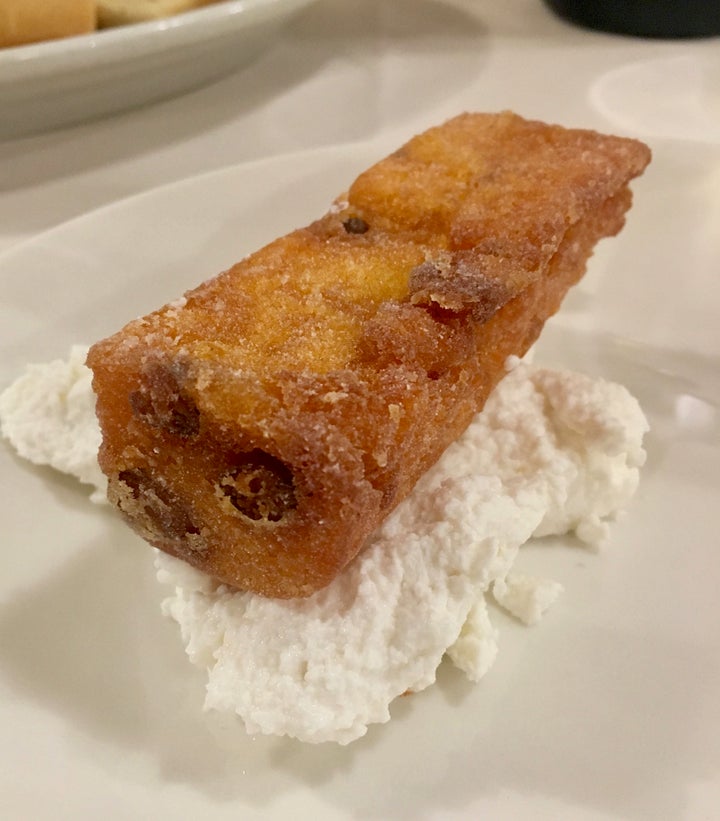
Calzagatti - polenta and beans, fried - at Trattoria Pomposa, Modena
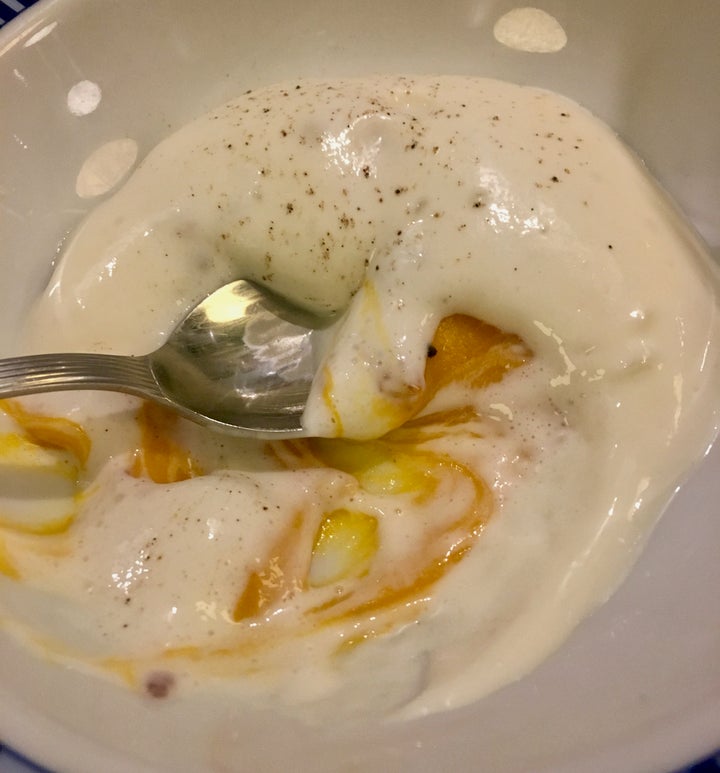
Pumpkin topped with parmesan cream at Franceschetta58, Modena

More parmesan cream, this one topped with truffles and blanketing Brussels sprouts and onion jam. At The Patricia restaurant, Newcastle, England

Deep-frying dried peppers gives them crunch: Here with cod and eggplant/aubergine at Franceschetta58, Modena

At Franceschetta58, the passatelli were served with octopus; when I make them, they’ll swim in rich broth
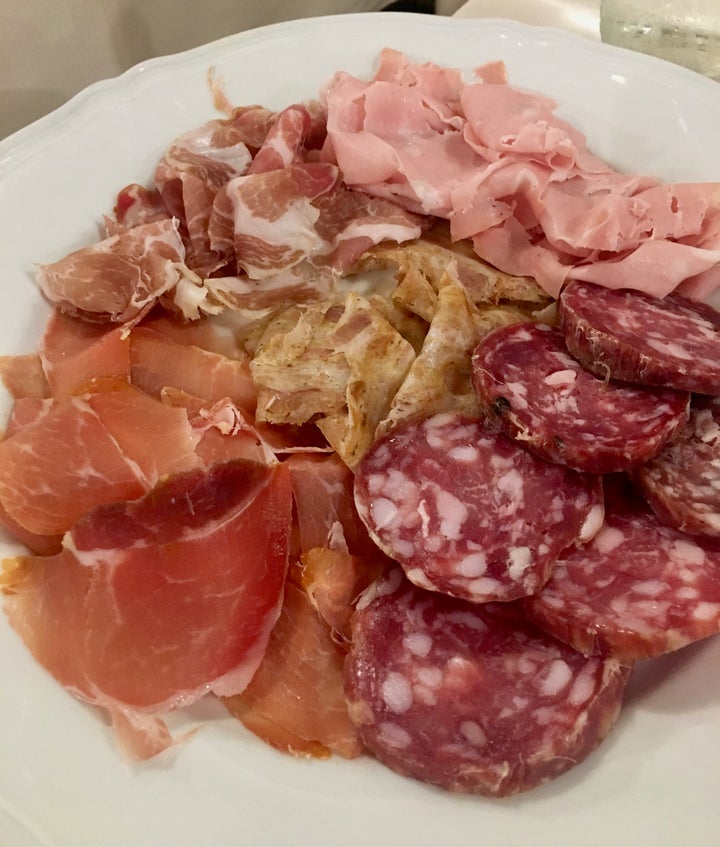
Salumi at Trattoria Pomposa, Modena. The beige slices in the center of the platter are ciccioli
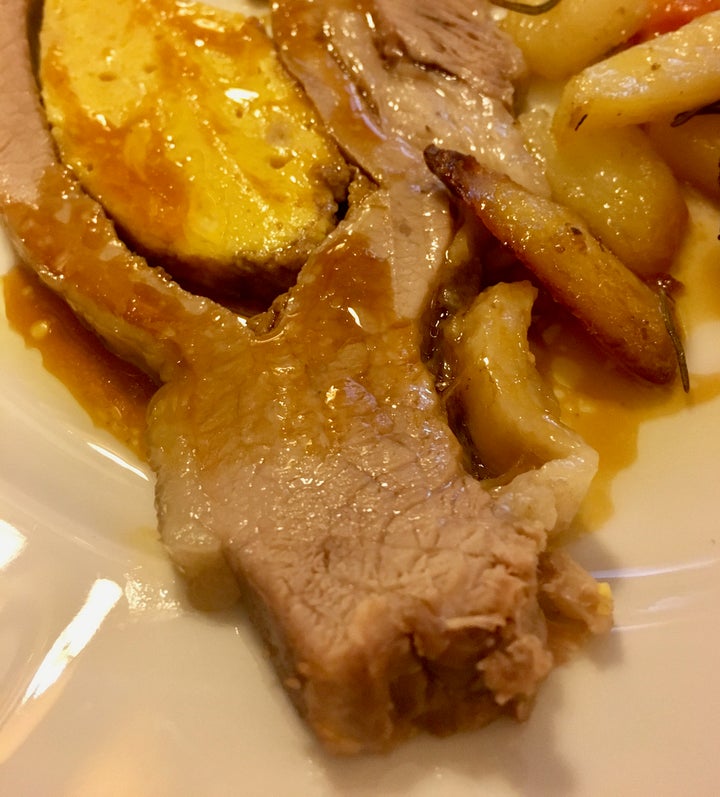
At Ristorante Cocchi, Parma, breast of veal stuffed with bread, eggs, cheese
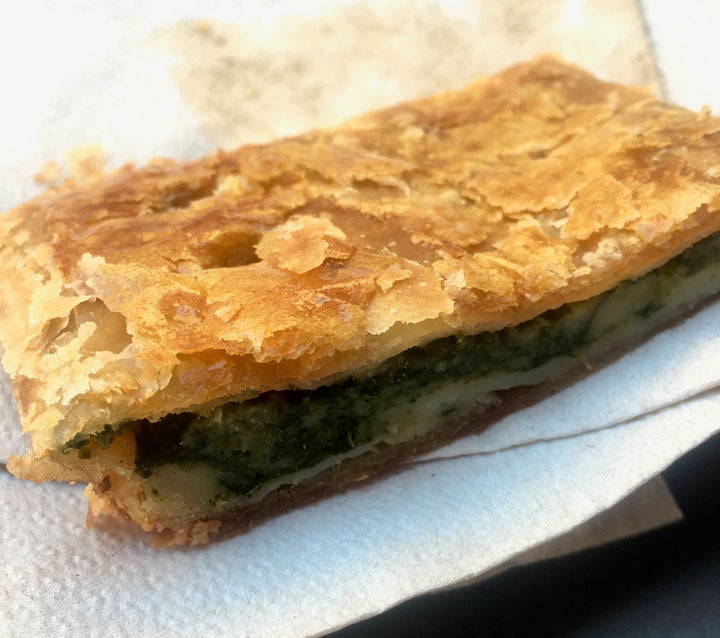
An afternoon snack of erbazzone at Caffetteria Giusti, Modena